| Author |
Message |
Bryan Heff

|
 Posted: Fri 06 Jul, 2012 11:58 am Post subject: Blade flex - Does it aid in cutting? Posted: Fri 06 Jul, 2012 11:58 am Post subject: Blade flex - Does it aid in cutting? |
 |
|
I realize that some flex in a blade is a benefit to ward against snapping the blade. Bend but don't break.
Other than that reason, are there any other benefits to having a spring or flex to a sword blade? Does it assist in cutting for instance?
I would think no, but I really don't know.
|
|
  |
 |
JE Sarge
Industry Professional

|
 Posted: Fri 06 Jul, 2012 3:14 pm Post subject: Posted: Fri 06 Jul, 2012 3:14 pm Post subject: |
 |
|
I used to have a Hanwei Federschwert that could whip around and smack my opponent in the side of helmet if they blocked it with their sword. Other than this, I don't personally see alot of use for too much blade flex. I don't think it helps in any way, as misaligns the edge during contact with harder targets in my experience. I like my blades pretty rigid, too much sag is bad juju IMHO. 
J.E. Sarge
Crusader Monk Sword Scabbards and Customizations
www.crusadermonk.com
"But lack of documentation, especially for such early times, is not to be considered as evidence of non-existance." - Ewart Oakeshott
|
|
  |
 |
|
Timo Nieminen
|
 Posted: Fri 06 Jul, 2012 3:25 pm Post subject: Re: Blade flex - Does it aid in cutting? Posted: Fri 06 Jul, 2012 3:25 pm Post subject: Re: Blade flex - Does it aid in cutting? |
 |
|
| Bryan Heff wrote: |
Other than that reason, are there any other benefits to having a spring or flex to a sword blade? Does it assist in cutting for instance? |
To address your second point first, no, it won't help cutting. It will reduce the cutting ability.
| Bryan Heff wrote: | | I realize that some flex in a blade is a benefit to ward against snapping the blade. Bend but don't break. |
But a thin wide blade cuts better. Wide is good, since it makes the blade very stiff in the plane of the cut (flex this way would be much worse than sideways flex when cutting), and gives small edge angles. Thin is good, because it also gives small edge angles, and doesn't require much displacement of the target to cut deeply.
Thin also means light. Light is important. Important enough for it to be worthwhile putting in fullers etc.
But thin means bendy - 1/2 the thickness means 1/8 the resistance against bending.
As for "bend but don't break" (or take a set), breaking (for brittle blades) or taking a set (for non-brittle blades), it all depends on how much the material is strained. If this exceeds the yield strain, it breaks or is permanently deformed. (Yield strain for low-carbon steels is typically about 0.1% - that is, if a 1 metre length is stretched by more than 1mm, it'll permanently deform. High-carbon steels easily get to double this, and well heat-treated spring steels can exceed 0.5%.)
A thin blade will bend to some angle while deforming the steel less, compared to a thick blade. On the other hand, it's much easier to bend it to that angle (and also far enough to permanently deform or break it).
Yes, you'd rather the blade bend like a spring (and return true) than break. But a very stiff blade can manage this, too - it just won't bend very far, under the same force, as a more flexible blade.
With some exceptions (fencing foils, Indian belt swords), blade flexibility is a symptom of thinness or lightness that's accepted because the loss in performance isn't very big, and the advantages of thinner/lighter are bigger.
"In addition to being efficient, all pole arms were quite nice to look at." - Cherney Berg, A hideous history of weapons, Collier 1963.
|
|
   |
 |
|
Matthew P. Adams
|
 Posted: Fri 06 Jul, 2012 3:39 pm Post subject: Posted: Fri 06 Jul, 2012 3:39 pm Post subject: |
 |
|
I think the only way flex helps, is by being the result of a lighter blade. If I understand correctly if you double the weight you double the impact, but if you double it's speed then you hit four times as hard. So having a lighter faster blade helps with both control and impact force. Then there is an acceptable amount of flex to impart on a sword while seeking a minimum weight and optimal handling.
Unless that flex is the result of inadequate distall taper. Then there is too much weight out towards the tip, and the structure of the blade isn't firm enough to support it. That is what I think of as whippy.
"We do not rise to the level of our expectations. We fall to the level of our training" Archilochus, Greek Soldier, Poet, c. 650 BC
|
|
  |
 |
|
R. Kolick
|
 Posted: Fri 06 Jul, 2012 4:40 pm Post subject: Posted: Fri 06 Jul, 2012 4:40 pm Post subject: |
 |
|
|
insomuch as helping the cut no there is no benifit that i know of but as to a benifit of flex is some really nasty wounds i read about a type of sword in india that had a wide but extreamly thin blade so it could cut well but would flex when its in the wound widening the gap and increasing the trauma not sure if it realy had much impact on damage because it seems to me that a cut deep enough for it to matter would already be mortal but it seems like it had a purpose
|
|
  |
 |
|
William P
|
 Posted: Sat 07 Jul, 2012 3:16 am Post subject: Posted: Sat 07 Jul, 2012 3:16 am Post subject: |
 |
|
| Matthew P. Adams wrote: | I think the only way flex helps, is by being the result of a lighter blade. If I understand correctly if you double the weight you double the impact, but if you double it's speed then you hit four times as hard. So having a lighter faster blade helps with both control and impact force. Then there is an acceptable amount of flex to impart on a sword while seeking a minimum weight and optimal handling.
Unless that flex is the result of inadequate distal taper. Then there is too much weight out towards the tip, and the structure of the blade isn't firm enough to support it. That is what I think of as whippy. |
although naturally your muscles can only contract so quickly, at some point it becomes pointless for a weapon to be any lighter because it will be propelled as fast as is possible by muscle torque alone.
and more importantly it depends on if you even CAN propel it twice as fast regardless due to, as mentioned a upper ceiling in terms of muscle contraction speed.
|
|
   |
 |
Johan Gemvik

|
 Posted: Sat 07 Jul, 2012 4:53 am Post subject: Posted: Sat 07 Jul, 2012 4:53 am Post subject: |
 |
|
A very interesting question and some very good answers so far.
As has been stated already but in other terms, when a blade flexes it loses a portion of the intended kinetic energy into the target and instead uses mechanical energy in flexing the blade, often this goes on to create a jarring resonance in the blade, losing further energy. The stiffer blade the better to translate energy into the intended target to make for an optimally powerful shearing cut. But a blade will need some flex or it could just snap in two if it's high temperd.
This is also the very reason you want to hit at a node where the least resonace is created, swords usually have one about 2/3 up the blade and a secondary one close to the hilt. But there are exceptions, or blades made to not resonate as much as most where this becomes less obvious, and less of a necessity to be that precise with the cut.
Why do swords have flex in the first place?
Well for starters, some don't or don't in the sense we see in spring tempered monosteel swords sold most today.
But the flex comes from tempering steel to spring hardness so it returns to true straight after it's bent. Below that temper level you get a sword that'll bend and stay that way instead. The edge can be a consideraby higher temper hardness than the body so i keeps an edge well, this is called differential heat treatment.
To temper a steel blade, or any steel with enough carbon in it to be able to take a temper, you heat it to a point where it's not magnetic anymore (yellow/white hot) then quench in a liquid medium to cool it quickly. If done right this makes it very hard but brittle like glass. So you take away some hardness by annealing, re-heating to some degree so it becomes semi-hard but no longer brittle. This has the side effect of making steel springy.
"The Dwarf sees farther than the Giant when he has the giant's shoulder to mount on" -Coleridge
|
|
  |
 |
|
Matthew P. Adams
|
 Posted: Sat 07 Jul, 2012 11:35 am Post subject: Posted: Sat 07 Jul, 2012 11:35 am Post subject: |
 |
|
@ Johan,
I understood that flexibility was the result of geometry, and not hardness. That a newly quenched, untempered blade would still flex, and return to true, but the danger was in the edge chipping out.
Also a soft blade would flex and return, but a lack of edge holding ability was the result.
Now a properly quenched and tempered carbon steel blade will be able to be flexed further and return, but mainly the heat treat was for the edges, not for flexibility.
I'm no metallurgist, my knowledge base is more on the martial arts side, so I'm open to correction, but that was my understanding.
@ William,
Excellent point, there are limits to the speed that can be generated, but mainly my point was that speed is preferable to mass, for a sword to hit hard. Also a lighter weight means you can use it longer with less fatigue, and control it more easily. I really enjoy a light weapon, and some may not, and that's fine. If I had more interest in armored combat, than I would probably like a bit more mass than finesse, and there are certainly historical weapons that meet that category.
"We do not rise to the level of our expectations. We fall to the level of our training" Archilochus, Greek Soldier, Poet, c. 650 BC
|
|
  |
 |
J. Hargis

|
|
  |
 |
Glen A Cleeton

|
 Posted: Sat 07 Jul, 2012 1:02 pm Post subject: Posted: Sat 07 Jul, 2012 1:02 pm Post subject: |
 |
|
Yes, it is the cross section that will effect flex but it is temper that allows the steel to return. Play with a paper clip and you will see unhardened and untempered steel where it will reach a limit. Then compare a regular hardened and tempered spring that is meant to cycle thousands of times a minute. Those springs will have a limit as well but are tempered to allow the return from a larger angle. Maybe more easily seen than in an internal combustion engine but say, a retracting ball point pen. Both will have limits, just as flexing swords does.
Flexing swords for the heck of it can be detrimental, especially with a differentially harded blade such as a tradition katana and many production katana. Even with through hardened and tempered swords, there is a limit where the steel will start to bunch up and pile, jsut like the paper clip example. Although I do use that very thin sword pictured below as a demonstrator, I do it less and less because eventually it will likely snap before taking a set (German steel blades can be like that sometimes). It is a twentieth century dress/uniform sword in the age of modern automatic weapons, so it is really just a hilt on a stick but still made very,very well.
Thin sword blades flex when cutting, not generally before (or at least not so appreciably) the impact. Add mass to the equation. Very stiff swords that have good geometries can also be very effective cutters at a thicker dimension when sharpened well because of the larger or equal mass of the thinner blade. Think katana less than half the width of a type X but as much mass per inch. At the extremes, there may bee some difference in ability but it more often boils down the the handling of a sword and the targets used. I can do things with a XIIIa I cannot replicate with a katana and vice vs versa. It is often a matter of being one with any given sword, as opposed to "I hate this thing and can't do a thing with it". All swords have some compromises in one way or another.
Below attached a sword bending from the weight of the sword when held at the point. Super thin and not really a cutting sword because of little mass but would open up a slash in flesh quite easily, even when not really sharpened at all.
Then, a migration era sword that breezed through a mat and you can see some deflection remains after the cut but the blade surely returns to true and is not what some would regard as a buggy whip when handling the sword. You'll note that the cut piece is still on the bottom piece after the blade is already well past it. This was Bugei wara, which is accepted as an easy cut but I have used this sword on regular stiffer ytatami mats with no real difference in performance. Scary might be the word I am looking for. A purpose made cutting sword from Kevin Cashen for Dennis Boas. The steel is L6.
Cheers
GC
 Attachment: 30.82 KB Attachment: 30.82 KB
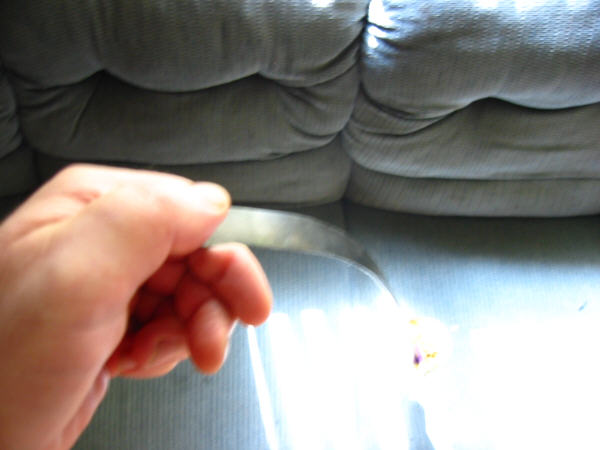
 Attachment: 59.21 KB Attachment: 59.21 KB
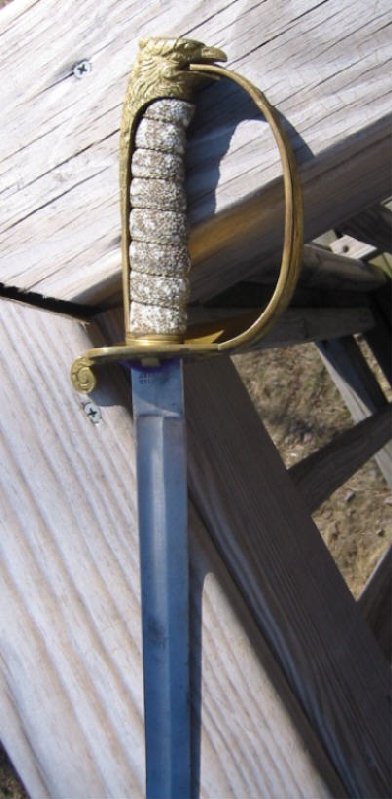
 Attachment: 123.43 KB Attachment: 123.43 KB
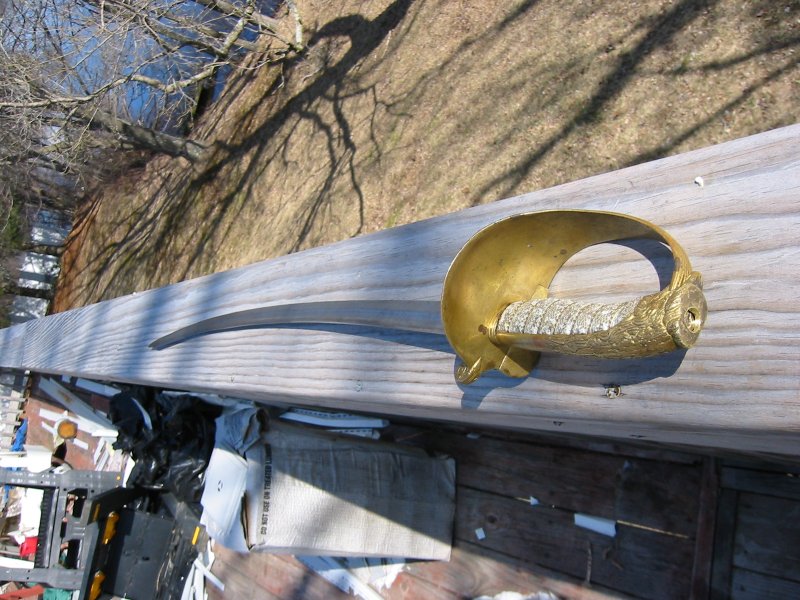
 Attachment: 139.04 KB Attachment: 139.04 KB

 Attachment: 43.75 KB Attachment: 43.75 KB
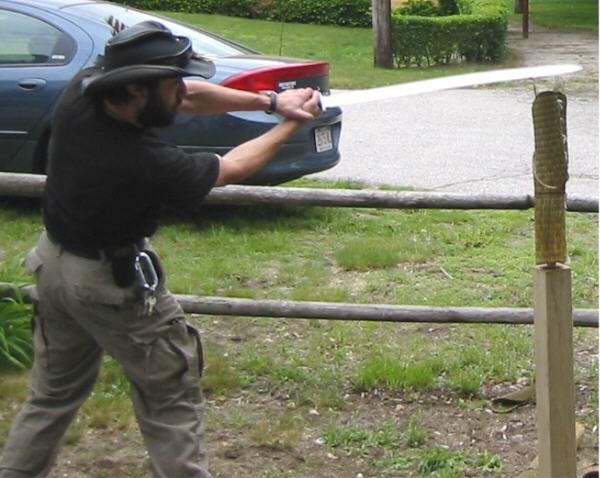
|
|
  |
 |
Glen A Cleeton

|
 Posted: Sat 07 Jul, 2012 1:27 pm Post subject: Posted: Sat 07 Jul, 2012 1:27 pm Post subject: |
 |
|
In response to stiff vs flexy cutting, here is an A&A German bastard, anything but flexy (it is a very riigid sword blade) lterally falling through the same wara (actually the same year some months later. There was more effort to ust slow it down than need to power through. Note the cut was made much closer to the point than what most figure as the best part of the blade to cut with. The GBS is a stiff and fairly thick blade at the pointy end.
Then there are the benefits of a katana, especially when cutting bricks. Please do not do this at home because it takes a lot of concentration and planning  I was not there but the trick was explained. The cutting photo is not photoshopped. I was not there but the trick was explained. The cutting photo is not photoshopped.
Cheers
GC
 Attachment: 35.88 KB Attachment: 35.88 KB

 Attachment: 30.19 KB Attachment: 30.19 KB
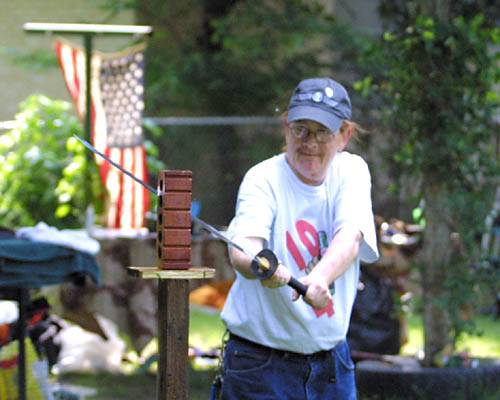
 Attachment: 32.38 KB Attachment: 32.38 KB
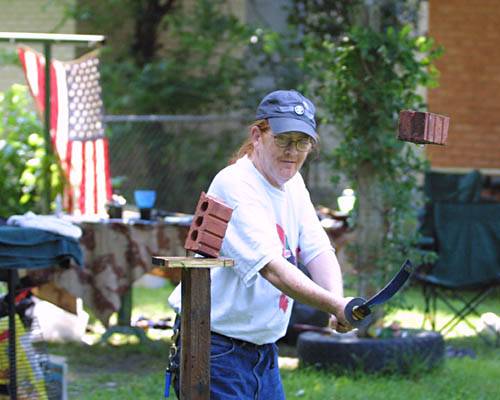
|
|
  |
 |
|
Timo Nieminen
|
 Posted: Sat 07 Jul, 2012 2:20 pm Post subject: Posted: Sat 07 Jul, 2012 2:20 pm Post subject: |
 |
|
| Johan Gemvik wrote: | | But a blade will need some flex or it could just snap in two if it's high temperd. |
This isn't so. Given a particular steel, a stiffer blade is always stronger. (No such thing as a steel blade with no flex - that's what you get for using steel instead of unobtainium.)
Stiffness is proportional to the thickness cubed. So, double the thickness, a given force well only bend the blade 1/8 as much. Halve the thickness, and it will bend 8 times as far.
But it isn't how far the blade is bent that determines failure, it's the strain (by what fraction the steel changes length along the sides). The strain is linearly proportional to the thickness and the deflection. So, for a given force, the strain is proportional to the inverse square of the thickness. Thus, the stiffer blade is always stronger, for a given steel.
The more flexible blade will be able to bend further without taking a set or breaking (halve the thickness, bend twice as far safely), but it takes less force to bend it that far.
Depending on what is applying the force to the blade, this ability to flex further can protect the blade, but only if flexing out of the way reduces the force. Otherwise, stiffer is better.
"In addition to being efficient, all pole arms were quite nice to look at." - Cherney Berg, A hideous history of weapons, Collier 1963.
|
|
   |
 |
|
Nat Lamb
|
 Posted: Sat 07 Jul, 2012 8:01 pm Post subject: Posted: Sat 07 Jul, 2012 8:01 pm Post subject: |
 |
|
The one time flex in blade *might* help is a cut into a “deep” soft target ( by deep here I mean wide on the axis extending from the person doing the cutting, perhaps a 20 litre water jug). If your cutting motion was not perfect, especially if your swing includes some movement away from the plane of the cut, some amount of flex or torsion might keep the edge better aligned as it moved through the target.
Even harder to describe using words than I expected, but an example of what I am talking about can be seen at about the 4:00 to 5:00 mark of the Chinese War Sword : Cold Steel Swords video on youtube. The guys doing the demo have a bit of a “dip” in some of the cuts, but the blade flexes and twists enough so that the edge stays true(ish).
Is it a major factor? Probably not. Is the flex going to cause problems in other situations? Absolutely. But there might be some quite particular situations where it might have some baring. I actually suspect that this scenario might have something to do with the specifics of the cutting medium…
|
|
  |
 |
Glen A Cleeton

|
 Posted: Sun 08 Jul, 2012 10:05 am Post subject: Posted: Sun 08 Jul, 2012 10:05 am Post subject: |
 |
|
| Nat Lamb wrote: | The one time flex in blade *might* help is a cut into a “deep” soft target ( by deep here I mean wide on the axis extending from the person doing the cutting, perhaps a 20 litre water jug). If your cutting motion was not perfect, especially if your swing includes some movement away from the plane of the cut, some amount of flex or torsion might keep the edge better aligned as it moved through the target.
Even harder to describe using words than I expected, but an example of what I am talking about can be seen at about the 4:00 to 5:00 mark of the Chinese War Sword : Cold Steel Swords video on youtube. The guys doing the demo have a bit of a “dip” in some of the cuts, but the blade flexes and twists enough so that the edge stays true(ish).
Is it a major factor? Probably not. Is the flex going to cause problems in other situations? Absolutely. But there might be some quite particular situations where it might have some baring. I actually suspect that this scenario might have something to do with the specifics of the cutting medium… |
My experience has been otherwise. While misaligned cuts can create a longer scooping cut in softer media, more often the depth is less. as the blade is deflected further out of alignment with the edge. Flexible swords deflect a great deal when baseball batting things such as water bottles. Every cut that fails in that matter and imparts the extreme flex cuse more shock to the sword.
Just like springs in a car, they wear out in time and sometimes break. I had a small coil spring in a forklift caster go off like a rifle shot because it had been loaded up beyond the capacity (fine tuning stand up narrow aisle straddle trucks). also a torsion bar on my Plymouth Duster. That one shattered in more than three three pieces at the fracture.
Thin blades cut softer media very well and can emulate some of the trick shots that are somewhat unreal. I used to spend a lot of time cutting empty empty cracker (pasteboard) boxes with light and heavier swords that were otherwise very thin in cross section. some do these same parlor tricks with thicker stiff blades. It has been awhile but I used to cut unpegged tatami stumps with my XIIIa and could not do that with my lowly Practical katana. Some of that may have been familiarity and tip speed of a longer blade.. The XIIIa is a quarter the thickness of the katana at the last few inches (foible) of blade
Forgive me but my memory excludes remembering who this gentleman was.
Cheers
GC
 Attachment: 11.14 KB Attachment: 11.14 KB

 Attachment: 22.36 KB Attachment: 22.36 KB
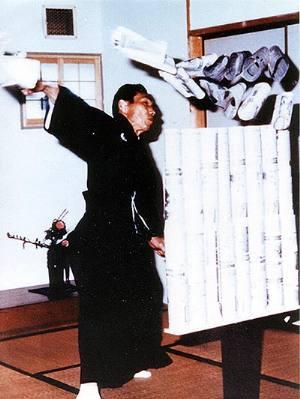
 Attachment: 24.08 KB Attachment: 24.08 KB
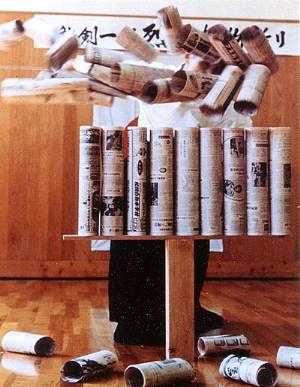
|
|
  |
 |
Johan Gemvik

|
 Posted: Tue 17 Jul, 2012 8:24 am Post subject: Posted: Tue 17 Jul, 2012 8:24 am Post subject: |
 |
|
| Timo Nieminen wrote: | | Johan Gemvik wrote: | | But a blade will need some flex or it could just snap in two if it's high temperd. |
This isn't so. Given a particular steel, a stiffer blade is always stronger. (No such thing as a steel blade with no flex - that's what you get for using steel instead of unobtainium.)
Stiffness is proportional to the thickness cubed. So, double the thickness, a given force well only bend the blade 1/8 as much. Halve the thickness, and it will bend 8 times as far.
But it isn't how far the blade is bent that determines failure, it's the strain (by what fraction the steel changes length along the sides). The strain is linearly proportional to the thickness and the deflection. So, for a given force, the strain is proportional to the inverse square of the thickness. Thus, the stiffer blade is always stronger, for a given steel.
The more flexible blade will be able to bend further without taking a set or breaking (halve the thickness, bend twice as far safely), but it takes less force to bend it that far.
Depending on what is applying the force to the blade, this ability to flex further can protect the blade, but only if flexing out of the way reduces the force. Otherwise, stiffer is better. |
Let me rephrase that so it becomes clearer what I meant. The tempering to the blade body needs to be spring steel level (what I meant by flex) or the blade will snap. I don't know why I didn't write it that way before. Perhaps I was already jumping ahead to another train of thought.
"The Dwarf sees farther than the Giant when he has the giant's shoulder to mount on" -Coleridge
|
|
  |
 |
Matt Easton

Location: Surrey, UK. Joined: 30 Jun 2004
Posts: 241
|
|
    |
 |
|
Timo Nieminen
|
 Posted: Tue 17 Jul, 2012 5:05 pm Post subject: Posted: Tue 17 Jul, 2012 5:05 pm Post subject: |
 |
|
| Johan Gemvik wrote: | | Timo Nieminen wrote: | | Johan Gemvik wrote: | | But a blade will need some flex or it could just snap in two if it's high temperd. |
This isn't so. Given a particular steel, a stiffer blade is always stronger. (No such thing as a steel blade with no flex - that's what you get for using steel instead of unobtainium.) |
Let me rephrase that so it becomes clearer what I meant. The tempering to the blade body needs to be spring steel level (what I meant by flex) or the blade will snap. I don't know why I didn't write it that way before. Perhaps I was already jumping ahead to another train of thought. |
Now that I can and do agree with.
The problem with the original phrasing is that, regardless of the temper or carbon content, all steel blades of the same geometry will flex the same amount (steels all have the same Young's modulus/elastic modulus) subject to the same force (if they don't break). Brittle blades will break when they flex too far, soft blades will take a set when they flex too far. So, the flex doesn't protect the blades, it is responsible for them breaking.
I like the new version you wrote.
| Matt Easton wrote: |
The stiffer a sword is, whilst retaining the requisite toughness, the better.
|
Indeed. And no problem to retain the toughness. Stiffness results from the geometry, toughness from the alloy and heat treatment.
| Matt Easton wrote: |
I can see no advantage to a flexible sword [...] |
Apart from training weapons (for safer thrusting) and pathological cases like the Indian belt sword, it's just a side effect of aiming for light and thin. The question then becomes "how much flexibility can be tolerated?".
"In addition to being efficient, all pole arms were quite nice to look at." - Cherney Berg, A hideous history of weapons, Collier 1963.
|
|
   |
 |
|
|
You cannot post new topics in this forum
You cannot reply to topics in this forum
You cannot edit your posts in this forum
You cannot delete your posts in this forum
You cannot vote in polls in this forum
You cannot attach files in this forum
You can download files in this forum
|
All contents © Copyright 2003-2025 myArmoury.com — All rights reserved
Discussion forums powered by phpBB © The phpBB Group
Switch to the Basic Low-bandwidth Version of the forum
|

